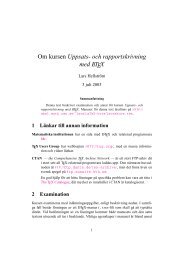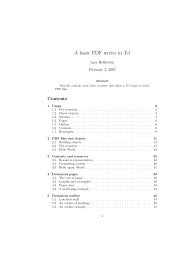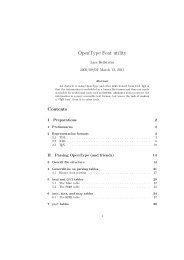The guessing number of undirected graphs - Index of
The guessing number of undirected graphs - Index of
The guessing number of undirected graphs - Index of
Create successful ePaper yourself
Turn your PDF publications into a flip-book with our unique Google optimized e-Paper software.
<strong>The</strong><strong>guessing</strong><strong>number</strong><strong>of</strong><strong>undirected</strong><strong>graphs</strong><br />
DemetresChrist<strong>of</strong>idesandKlasMarkström<br />
Abstract<br />
In[Rii07],Riisintroduceda<strong>guessing</strong>gamefor<strong>graphs</strong>whichisequivalent<br />
t<strong>of</strong>indingprotocolsfornetworkcoding.Inthispaperweproveupperand<br />
lowerboundsforthewinningprobability<strong>of</strong>the<strong>guessing</strong>gameon<strong>undirected</strong><br />
<strong>graphs</strong>.Wefindoptimalboundsforperfect<strong>graphs</strong>andminimallyimperfect<br />
<strong>graphs</strong>,andpresentaconjecturerelatingtheexactvalueforall<strong>graphs</strong>to<br />
thefractionalchromatic<strong>number</strong>.<br />
Finally, we discuss extensions <strong>of</strong> our results to directed <strong>graphs</strong> and<br />
<strong>graphs</strong>withnon-uniformprobabilities.<br />
1 Introduction<br />
Anactivearea<strong>of</strong>researchincommunicationtheoryduringthelasttenyears<br />
hasbeenthedevelopment<strong>of</strong>protocolsfornetworkcoding[ACLY00].Innetwork<br />
codingthereareseveralsendersandreceiverswhowishtopassmessagesbetween<br />
eachother,howevertheroutersinthenetworkcanonlysendonemessageat<br />
atime. Inordertoavoidbottlenecks,networkcodingallowstheroutersto<br />
computeanddistributenewmessages,aslongasthereceiverscancomputethe<br />
senders’originalmessagefromthecollection<strong>of</strong>newmessagestheyreceivedin<br />
itsstead.<br />
In[Rii07],Riisconnectednetworkcodingtothemucholderproblem<strong>of</strong>finding<br />
an optimalBooleancircuitforaBooleanfunction. In thatpaper, Riis<br />
disprovedaconjecture<strong>of</strong>Valiantincircuitcomplexityandshowedthatboth<br />
networkcodingandthisform<strong>of</strong>circuitcomplexitywereequivalenttoacertain<br />
type<strong>of</strong>multiplayer<strong>guessing</strong>gameonagraph.<br />
<strong>The</strong><strong>guessing</strong>gamecanbedescribedasfollows:Eachvertexv<strong>of</strong>agraphG<br />
isassignedaplayer,alsodenotedbyv,andauniformlyrandomintegerfrom<br />
{1...s}. Aplayervcanseethe<strong>number</strong>sassignedattheneighbours<strong>of</strong>v,but<br />
notthe<strong>number</strong>atv. Withoutcommunication,eachplayermustnowmakea<br />
guessastothevalue<strong>of</strong>itsownrandom<strong>number</strong>. <strong>The</strong>team<strong>of</strong>playerswins<br />
ifall<strong>of</strong>themguesscorrectlytheirownvalue,andlosesifanyoneisincorrect.<br />
<strong>The</strong>objectiveistonowfindastrategywhichmakesthewinningprobabilityas<br />
largeaspossible.Atfirstitmightseemlikethereisnoway<strong>of</strong>gettingahigher<br />
winningprobabilitythans −n onannvertexgraph,butRiisobservedthatthis<br />
isfarfrombeingthecase. IfGisthecompletegraph,theplayerscanusethe<br />
1
followingsimplestrategy: Eachplayerpickstheunique<strong>number</strong>suchthatthe<br />
sum<strong>of</strong>thatandallother<strong>number</strong>sis0modulos. Ifeveryplayerfollowsthis<br />
strategytheywillallbecorrectwhenthesum<strong>of</strong>all<strong>number</strong>is0modulos,which<br />
happenswithprobabilitys −1 ,avaluewhichdosnotevendependonn.<br />
In[Rii07],Riisconsideredthisgameongeneraldirected<strong>graphs</strong>,whereplayer<br />
vcanseethe<strong>number</strong>atvertexuifandonlyifthereisanedgefromvtou.<br />
Motivatedby thisgeneralquestion, inthispaperwe studytheproblemfor<br />
<strong>undirected</strong><strong>graphs</strong>. Asweshallsee,theproblem<strong>of</strong>findingoptimal<strong>guessing</strong><br />
gamestrategiescanbetranslatedintoaquestionregardingthesize<strong>of</strong>thelargest<br />
independentsetinanauxiliarygraph,andusingthisgraphwecanfindgood<br />
boundsforthewinningprobabilities.<br />
Hereisanoutline<strong>of</strong>thepaper.Inthenextsectionwegivesomeformaldefinitionsandprovesomebasicboundsforthewinningprobability<strong>of</strong>the<strong>guessing</strong><br />
games. InSection3,weexplainhowthe<strong>guessing</strong><strong>number</strong>scanbedetermined<br />
bycomputingthefixedpoints<strong>of</strong>somespecificmaps. Wealsousethemethods<br />
developedtheretoshowthatthereisanaturallydefinedlimit<strong>of</strong>the<strong>guessing</strong><br />
<strong>number</strong>swhichwecalltheasymptotic<strong>guessing</strong><strong>number</strong>. InSection4,wefind<br />
lowerboundsonthe<strong>guessing</strong><strong>number</strong>susingfractionalcliquecovers.InSection<br />
5,wedefinethecodegraph<strong>of</strong>the<strong>guessing</strong>gameandprovethatthe<strong>guessing</strong><br />
<strong>number</strong>canbecomputedbydeterminingtheindependence<strong>number</strong><strong>of</strong>thisgraph.<br />
InSection6,wefindupperboundsonthe<strong>guessing</strong><strong>number</strong>susingentropyinequalitiesandposeaconjectureregardingtheasymptotic<strong>guessing</strong><strong>number</strong><strong>of</strong><br />
eachgraph.FinallyinSection7weconsidersomegeneralisations<strong>of</strong>themethods<br />
<strong>of</strong>thepaperinsimilarcontexts.<br />
2 Definitionsandsomebasicbounds<br />
Westartoutbymakingamoreformaldefinition<strong>of</strong>the<strong>guessing</strong>game.<br />
Definition2.1.Inthe<strong>guessing</strong>gameonagraphG,eachvertexvisassigned<br />
anintegerxv∈{1,...,s}uniformlyatrandom.<br />
Givenavertexv<strong>of</strong>agraphG,astrategyforplayervforthe<strong>guessing</strong>game<br />
onGisafunctionfv :{1,...,s} N(v) →{1,...,s}. <strong>The</strong>value<strong>of</strong>fviscalled<br />
v’sguess. AstrategyFforthe<strong>guessing</strong>gameonGisasequence<strong>of</strong>functions<br />
(fv) v∈V(G)suchthateachfunctionfvisastrategyforplayervforthe<strong>guessing</strong><br />
game.<br />
WesaythattheplayerswinifallguessesarecorrectandwewriteCor(F)<br />
todenotethisevent.<br />
Wenowdefinethe<strong>guessing</strong><strong>number</strong><strong>of</strong>thegraphviathewinningprobability<br />
intheoptimalstrategyforthatgraph.<br />
Definition2.2. <strong>The</strong><strong>guessing</strong><strong>number</strong>gn(G,s)<strong>of</strong>agraphGwithrespectto<br />
thepositiveintegersisthelargestβsuchthatthereexistsastrategyFforthe<br />
<strong>guessing</strong>gameonGsuchthatwithprobability 1<br />
s n−β everyplayervguessesits<br />
ownvaluexv,i.e.Pr(Cor(F))= 1<br />
s n−β.<br />
2
Ingeneral,onecouldconsiderstrategieswhereeachplayermakesarandom<br />
choicebasedontheavailableinformation. Howeverthereisalwaysanoptimal<br />
strategywhichisdeterministic,soweonlyconsiderdeterministicstrategies.<br />
Lemma2.3. Everyrandomisedstrategyforthe<strong>guessing</strong>gameonagraphG<br />
haswinningprobabilityatmost 1<br />
s n−gn(G,s).<br />
Pro<strong>of</strong>.ArandomisedstrategycanbedescribedbyassigningaprobabilityPr(F)<br />
toeachdeterministicstrategyF. Howeverthewinningprobability<strong>of</strong>sucha<br />
strategyis<br />
<br />
F<br />
Pr(F)Pr(Cor(F))max<br />
F Pr(Cor(F))=<br />
1<br />
s n−gn(G,s).<br />
Usingthisterminologywecannowgiveaformalversion<strong>of</strong>thestrategyfor<br />
thecompletegraphwhichwedescribedintheintroduction.<br />
Example 2.4. LetGbethe completegraphKn on nvertices. Wedefine<br />
a strategyforthe <strong>guessing</strong>gameon G by definingfv tomap thesequence<br />
(xu) u∈N(v)totheuniqueintegerx ′ v∈{1,...,s}suchthatx ′ v+ <br />
u∈N(v) xuis<br />
divisiblebys.Wewillcallthisthecliquestrategy.Observethatalltheplayers<br />
guesscorrectlyifandonlyifx ′ v=xvforeveryv∈V(G)whichholdsifandonly<br />
if <br />
. Since<br />
v∈V(G) xvisdivisiblebys. <strong>The</strong>probability<strong>of</strong>thiseventisthus 1<br />
s<br />
theprobabilitythatasingleplayerguessesitsownvaluecorrectlyisalso 1<br />
s ,this<br />
cannotbeimprovedandwefindthatgn(Kn,s)=n−1.<br />
Fromthecliquestrategywecandefineanaturalstrategyforgeneral<strong>graphs</strong><br />
bypartitioningthevertexsetintocliques.<br />
Definition2.5.Acliquecover,orcliquepartition<strong>of</strong>agraphGisapartition<br />
<strong>of</strong>V(G)intovertexdisjointcliques.<strong>The</strong>cliquecover<strong>number</strong>cp(G)<strong>of</strong>Gisthe<br />
minimumcardinality<strong>of</strong>acliquecover<strong>of</strong>G.<br />
Notethatthecliquesinacliquecover<strong>of</strong>Ginduceapartition<strong>of</strong>thecomplement<strong>of</strong>Gintoindependentsets,i.e.apropervertexcolouring<strong>of</strong>G.<br />
Hence<br />
cp(G)=χ G .<br />
Lemma2.6.ForeverygraphGandeverypositiveintegers,gn(G,s)n−<br />
cp(G)<br />
Pro<strong>of</strong>.Astrategygivingthisboundcanbeconstructedbytakingaminimal<br />
cliquecoverandlettingtheplayersineachcliquefollowthecliquestrategyfor<br />
thatclique.Thisgivesprobabilityatleast 1<br />
s cp(G)thatallplayersguesscorrectly.<br />
Wecallthestrategyusedinthepro<strong>of</strong><strong>of</strong>theabovelemma,thecliquecover<br />
strategy.<br />
Intheotherdirection,wecanproveanupperboundonthewinningprobabilitybyconsideringindependentsetsinthegraph.Asusual,weletα(G)denote<br />
thesize<strong>of</strong>thelargestindependentsetinG.<br />
3
Lemma2.7.ForeverygraphGandeverypositiveintegers,gn(G,s)n−α(G)<br />
Pro<strong>of</strong>.LetIbeamaximumindependentsetinGandletF =(fv) v∈V(G)be<br />
astrategy. Wechoosetherandom<strong>number</strong>(xu) u∈V(G)intwostages. Inthe<br />
firststage,wegenerateall<strong>number</strong>sxu withu /∈I. ObservethatsinceI is<br />
independentallfunctionsfuwithu∈Icannowbedetermined. Inthesecond<br />
stage,wegenerateall<strong>number</strong>sxuwithu∈Iandobservethattheprobability<br />
thatplayervguessescorrectlyisexactly1/swiththeeventsbeingindependent.<br />
ItfollowsthatPr(Cor(F))s −α(G) asrequired.<br />
Eventhesetwosimpleboundsareenoughtodeterminethe<strong>guessing</strong><strong>number</strong>s<br />
exactlyforlargeclasses<strong>of</strong><strong>graphs</strong>. Infact,thesetwoboundsdeterminethe<br />
<strong>guessing</strong><strong>number</strong><strong>of</strong>Gpreciselywhenα(G)=cp(G). Oneparticularlynatural<br />
classwhichsatisfiesthispropertyistheclass<strong>of</strong>perfect<strong>graphs</strong>,introducedby<br />
Berge[Ber63].Thisistheclass<strong>of</strong><strong>graphs</strong>suchthatχ(H)=ω(H)forallinduced<br />
sub<strong>graphs</strong><strong>of</strong>G. Aclassicaltheorem<strong>of</strong>Lovász[Lov72]tellsusthatagraphis<br />
perfectifandonlyifitscomplementisperfect. Inourcontextthismeansthat<br />
foraperfectgraphGwehaveα(G)=ω(G)=χ G =cp(G)<br />
Corollary2.8.IfGisperfectthengn(G)=n−α(G).<br />
ThistellsusamongotherthingsthatifGisbipartitethengn(G,s)=n−<br />
α(G).Onestrikingconsequenceisthatadisjointunion<strong>of</strong>nK2’s,i.e.amatching<br />
<strong>of</strong>sizenhasthesame<strong>guessing</strong><strong>number</strong>asthecompletebipartitegraphKn,n,<br />
despitebeingasubgraph<strong>of</strong>ithavingafactor<strong>of</strong>nfeweredges.Inotherwords,<br />
allthisextrainformationthattheplayershaveinplayingthe<strong>guessing</strong><strong>number</strong><br />
forKn,ncontributesnothingtothewinningprobabilityforthe<strong>guessing</strong>game<br />
onthisgraphcomparedwiththe<strong>guessing</strong>gameonthematching<strong>of</strong>sizen.<br />
3 Fixedpointsandtheasymptotic<strong>guessing</strong><strong>number</strong><br />
Anotherway<strong>of</strong>describingthe<strong>guessing</strong>problemisinterms<strong>of</strong>fixedpoints<strong>of</strong>the<br />
mappingsgivenbydifferentstrategies.NotethatastrategyFcanbeviewedas<br />
amappingfromAs={1,...,s} V(G) intoitself.<strong>The</strong>strategyFguessescorrectly<br />
onagivenoutcome<strong>of</strong>random<strong>number</strong>sx=(xv) v∈V(G)ifF(x)=x. Thusthe<br />
problem<strong>of</strong>findingagoodstrategyforthe<strong>guessing</strong>gamecanbeinterpretedas<br />
findingamappingF:As→Aswithasmanyfixedpointsaspossible,wherefv<br />
onlydependsonxu∈N(v).Wecallamappingwiththedependencestructurea<br />
strategymappinganddenotetheset<strong>of</strong>allstrategymappingsonAsbyS(G,s).<br />
IfweletFix(F)denotethe<strong>number</strong><strong>of</strong>fixedpoints,thenwecancomputethe<br />
<strong>guessing</strong><strong>number</strong>as<br />
gn(G,s)= max<br />
F∈S(G,s) log sFix(F)<br />
LetusdefineFix(G,s)=max F∈S(G,s)Fix(F).<br />
Whilethe<strong>guessing</strong><strong>number</strong>isgivenbythemaximum<strong>number</strong><strong>of</strong>fixedpoints<br />
foramapping<strong>of</strong>thistypetherearealsomappingsattheotherextremewithno<br />
fixedpoints,foreverynon-trivialgraph.<br />
4
Example 3.1. LetG=K2 andtakes=2. Letthefirstplayerguessthe<br />
samevalueashesees(i.e.theoutcome<strong>of</strong>therandomexperiment<strong>of</strong>thesecond<br />
player),andletthesecondplayerguesstheopposite<strong>of</strong>thevalueitsees.Forthis<br />
strategy,Fix(F)=0. Thusforeverygraphwithatleastoneedgethereexists<br />
astrategywhichneverguessesallvaluescorrectly,andthiscanbeextended<br />
tolargersaswell. Thisis<strong>of</strong>coursetobeexpectedastheaverage<strong>number</strong><strong>of</strong><br />
fixedpointsoverallstrategymappingsis1. Soifweareablet<strong>of</strong>indstrategy<br />
mappingswithmorefixedpoints,thentheremustalsoexiststrategymappings<br />
withn<strong>of</strong>ixedpointsatall.<br />
S<strong>of</strong>ar,foralltheexamples<strong>of</strong><strong>graphs</strong>wehaveseen,the<strong>guessing</strong><strong>number</strong>was<br />
independent<strong>of</strong>s. Ourearlierresultsshowthatinordertoseeadependence<br />
onswemustconsidernon-perfect<strong>graphs</strong>. <strong>The</strong>strongperfectgraphtheorem<br />
[CRST06]tellsusthatagraphisperfectifandonlyifneitherGnoritscomplementcontainsaninducedoddcycle<strong>of</strong>lengthatleastfive.<br />
Soweturnour<br />
attentiontothefivecycleC5,whichisthesmallestnon-perfectgraph.<br />
Example3.2.LetG=C5,bethecycleon5vertices. Sinceα(C5)=2and<br />
χ(C5)=3,Lemmas2.6and2.7give2gn(G,s)3foreverys.<br />
Fors=2,letFbethestrategywhereavertexguesses2ifbothitsneighbours<br />
havevalue1,andguesses1otherwise.Thisstrategyguessescorrectlyonthefollowingx:{11212,12112,12121,21121,21211}.Thuswehavegn(C5,2)log<br />
25,<br />
andaquickcomputercheckshowsthatthisisindeedoptimal.<br />
Fors=3,letFbethestrategywhereavertexguesses2ifbothitsneighbours<br />
havevalue1,guesses3ifatleastoneneighbourhasvalues3andnoneighbourhas<br />
value2,andguesses1otherwise.ThisstrategyhasFix(F)=11andacomputer<br />
checkshowsthatitisthebestsymmetricstrategy.Howeverbycomputercheck,<br />
usingthemethods<strong>of</strong>thenextsection,weknowthatthereexistsamorecomplex,<br />
vertexdependent,strategywhichisoptimalandhasFix(F)=12.Thuswehave<br />
gn(C5,3)=log 312
leastonu∈N(v),thenf ′ v(x)=s+1,otherwisef ′ v(x)=fv(x ′ ),wherex ′ is<br />
obtainedfromxbydefiningx ′ utobeequaltoxuifxu∈{1,...,s}andequalto<br />
1otherwise.ObservethatF ′ isindeedastrategymapping,everyfixedpoint<strong>of</strong><br />
Fisalsoafixedpoint<strong>of</strong>F ′ andmoreoverF ′ has(s+1,...,s+1)asafixed<br />
pointaswell.<br />
Lemma3.4.IfHisasubgraph<strong>of</strong>GthenFix(H,s)Fix(G,s)<br />
Pro<strong>of</strong>.GivenastrategymappingFforthe<strong>guessing</strong>gameonH,weextendit<br />
toastrategymappingF ′ forthe<strong>guessing</strong>gameonGbydefiningf ′ v(x)tobe<br />
equalt<strong>of</strong>v({xu:u∈V(H)})ifv∈V(H)andtobeidentically1otherwise.It<br />
isimmediatethatF ′ isastrategymappinghavingatleastasmanyfixedpoints<br />
asF.<br />
<strong>The</strong>lastinequalityisveryfarfrombeingstrict,asshownbyourearlier<br />
examplewiththebalancedcompletebipartitegraphon2nverticesversusthe<br />
matching<strong>of</strong>sizen.<br />
Wecanalsoboundthe<strong>number</strong><strong>of</strong>fixedpointsforcompositevalues<strong>of</strong>s<br />
Lemma3.5.Fix(G,s1s2)Fix(G,s1)Fix(G,s2)<br />
Pro<strong>of</strong>.Thisfollowsbysimplywritingeachrandom<strong>number</strong>xvas(a−1)s1+b,<br />
withb∈{1,...,s1}anda∈{1,...,s2},andusingtheoptimalmappingsfors1<br />
ands2toguessaandbindependently.<br />
<strong>The</strong>orem3.6.<strong>The</strong>limitlims→∞log sFix(G,s)exists,andisatmost|V(G)|.<br />
Moreover,itisequaltosup s∈Nlog sFix(G,s).<br />
Pro<strong>of</strong>.SupposeGhasnverticesandletuswriteas=Fix(G,s).Bythedefinition<strong>of</strong>Fix(G,s)itfollowsthatass<br />
n foreverysandsoifthelimitexiststhen<br />
itisatmostn. ByLemma3.3wehavethatas+1asforeverys∈Nandby<br />
Lemma3.5wehavethatastasatforeverys,t∈N.Ouraimistoshowthat<br />
lims→∞log sasexistsandisequaltosup s∈Nlog sas.Givens,t∈Nweclaimthat<br />
log sas k<br />
k+1 log tat,<br />
wherek=⌈logs/logt⌉. <strong>The</strong>resultimmediatelyfollows. Indeed,givenε>0,<br />
letℓ=sup s∈Nlog sasandtaketlargeenoughsuchthatlog tat>(1−ε)ℓ.With<br />
thistfixed,wecannowpickslargeenoughsuchthatk/(k+1)>(1−ε).We<br />
deducethatlog sas>(1−ε) 2 ℓ,thusliminflog sasℓandsolimlog sasexists<br />
andisequaltoℓ.Toprovetheclaim,observethat<br />
logsas= logtas logts logtatk logttk+1log tak t<br />
k+1<br />
= k<br />
k+1 log tat.<br />
Hencemayintroducethefollowingasymptoticversion<strong>of</strong>the<strong>guessing</strong><strong>number</strong>.<br />
6
Definition3.7.<strong>The</strong>asymptotic<strong>guessing</strong><strong>number</strong>gn(G)<strong>of</strong>Gis<br />
gn(G)= lim<br />
s→∞ log sFix(G,s)<br />
Example3.8.LetusreturnbacktoC5.Wehavealreadyseenthatgn(C5,2 k )<br />
gn(C5,2)=log 25.Itfollowsthatgn(C5)log 25.Inparticulargn(C5)>2.In<br />
thenextsectionwewillimprovefurtheronthisbound.<br />
4 Lowerboundsviafractionalcliquecovers.<br />
S<strong>of</strong>arwehavedeterminedexactlythe<strong>guessing</strong><strong>number</strong>s<strong>of</strong>perfect<strong>graphs</strong>and<br />
foundanon-triviallowerboundfortheasymptotic<strong>guessing</strong><strong>number</strong><strong>of</strong>C5. In<br />
fact,amuchbetterboundcanbederivedforbothC5andothernon-perfect<br />
<strong>graphs</strong>bymakinguse<strong>of</strong>afractionalcoverings.Beforedefiningfractionalcoveringsweintroducethet-foldblowup<strong>of</strong><strong>graphs</strong>andtheblow-upstrategy.<br />
Definition4.1.GivenagraphGwedefinethet-foldblowup<strong>of</strong>G,denotedby<br />
G t ,asfollows:ForeachvertexvinGtherearetverticesv1,...,vtinG t with<br />
verticesviandujbeingneighboursinG t ifandonlyifvanduareneighbours<br />
inG.<br />
Laterwewillalsoneedthefollowingspecialcase<strong>of</strong>thestronggraphproduct.<br />
Definition4.2.<strong>The</strong>strongproduct<strong>of</strong>KtandG,denotedKt∗Gisthegraph<br />
obtainedfromG t byaddingalledges<strong>of</strong>theform(vi,vj)foreachvertexvinG.<br />
Wecanusethet-blowup<strong>of</strong>Gtoobtainbetterboundsforthe<strong>guessing</strong><br />
<strong>number</strong><strong>of</strong>Gwithrespecttovalues<strong>of</strong>swhichareperfecttpowers.<br />
Definition4.3.LetGbeagraph,lettbeapositiveintegerandlets=s t 1<br />
forsomeintegers1>1. GivenanystrategyF forG t withrespecttos t 1 ,we<br />
canobtainastrategy,whichwecalltheblow-upstrategy,forGwithrespect<br />
tosasfollows: Ifxisthe<strong>number</strong>assignedtoavertexv<strong>of</strong>G,wewritex=<br />
t i−1<br />
i=1 (xi−1)s1 ,wherexi∈{1,...,s1}foreachi.<strong>The</strong>nweassignthe<strong>number</strong>s<br />
x1,...,xttotheverticesv1,...,vt<strong>of</strong>G t .WethenfollowthestrategyFonG t .<br />
Ify1,...,ybarethe<strong>number</strong>sguessedbyFatverticesv1,...,vb,thenthe<strong>number</strong><br />
guessedbytheblow-upstrategyatvertexvwillbey= t<br />
i=1<br />
(yi−1)s i−1<br />
1 .<br />
Wenotethatasimilarblow-upstrategycanbeusedinthecasethatsisa<br />
product<strong>of</strong>t(notnecessarilyequal)integersstrictlygreaterthan1.Wediscuss<br />
howthiscanbedoneinsubsection7.1.<br />
<strong>The</strong>orem4.4.LetGbeagraphandlett,s1bepositiveintegers.<strong>The</strong>ngn(G,s)<br />
gn(G,s1).<br />
Pro<strong>of</strong>.ItisimmediatethatwecanpartitionG tintotvertexdisjointcopies<strong>of</strong>G. LetFbethestrategyonG twithrespecttos1whichfollowsthebestpossible strategyoneach<strong>of</strong>thistcopies<strong>of</strong>G. Wenowfollowtheblow-upstrategy.<br />
<strong>The</strong>winningprobabilityisatleasts −t(n−gn(G,s1))<br />
1 =s−(n−gn(G,s1)) andtheresult<br />
follows.<br />
7
WecouldhaveinfactprovedthistheoremusingLemma3.5instead. We<br />
willseeamorepowerfulapplication<strong>of</strong>theblow-upstrategyafterweintroduce<br />
fractionalcoverings<strong>of</strong><strong>graphs</strong>.<br />
Definition4.5. Afractionalcliquecover<strong>of</strong>agraphGisafamily<strong>of</strong>cliques<br />
H1,...,Ht<strong>of</strong>Gtogetherwithnon-negativeweightsw1,...,wtsuchthat <br />
{i:v∈Hi} wi<br />
1forallv ∈ V(G). <strong>The</strong> maximumvalue<strong>of</strong> t i=1wi overallcliquecovers<br />
H1,...,Ht<strong>of</strong>Gisknownasthefractionalcliquecover<strong>number</strong><strong>of</strong>Gandisdenotedbycp<br />
f(G). Itisalsoknownasthefractionalchromatic<strong>number</strong><strong>of</strong>the<br />
complementG<strong>of</strong>G,denotedbyχf(G).<br />
Itiswellknownthatcp f(G)isalwaysarational<strong>number</strong>andthatα(G)<br />
cp f(G)cp(G). Similarly,wehavethatω(G)χf(G)χ(G). One<strong>of</strong>the<br />
basicresultsinfractionalgraphtheoryletsusrelatethefractionalchromatic<br />
<strong>number</strong>tothechromatic<strong>number</strong><strong>of</strong>asuitableblowup<strong>of</strong>theoriginalgraph.<br />
Fortheseandotherresultsonfractionalgraphtheorywereferthereaderto<br />
[SU97].<br />
<strong>The</strong>orem4.6.ForeachgraphGthereexistsapositiveintegert,withsuchthat<br />
χf(G)= χ(Kt∗G)<br />
t .Equivalently,consideringthecomplement<strong>of</strong>Kt∗G,wehave<br />
cp f(G)= cp(Gt )<br />
t<br />
Observethatforanypositiveintegertandanyintegermultiples<strong>of</strong>twe<br />
havethatχ(Kt∗G)/tχ(Ks∗G)/sχf(G). Inparticular,iftisaninteger<br />
forwhichtheconsequence<strong>of</strong><strong>The</strong>orem4.6holds, thenitalsoholdsforany<br />
integermultiple<strong>of</strong>t. Notethatconsideringthecomplement<strong>of</strong>G,thereisan<br />
integert(notnecessarilythesameastheonegivenby<strong>The</strong>orem4.6)suchthat<br />
cp(G t )=tcpf(G).Sowecanuseacombination<strong>of</strong>thecliquecoverstrategyand<br />
theblow-upstrategytoobtainbetterstrategiesforthe<strong>guessing</strong>game.<br />
Definition4.7.LetGbeanygraphandlettbeanypositiveintegersuchthat<br />
cp(G t )=tcpf(G). <strong>The</strong>nthefractionalcliquestrategyisdefinedbytakingthe<br />
blow-upstrategy<strong>of</strong>Gwithrespecttothecliquecoverstrategy<strong>of</strong>G t .<br />
Example4.8. ConsiderthefractionalcliquestrategyforC5. <strong>The</strong>fractional<br />
chromatic<strong>number</strong><strong>of</strong>C5 is 5<br />
2 andafractionalcliquestrategyforC5 canbe<br />
obtainedbyusingthecliquecoverstrategyonthe2-foldblowupC 2 5 <strong>of</strong>C5.This<br />
graphisdepictedinFigure1,withacliquecoveringgivenbythethickedges.<br />
<strong>The</strong>orem4.9.LettbeanypositiveintegerasinDefinition4.7.<strong>The</strong>ngn(G,s)<br />
n−cp f(G)wheneversisaperfectt-power.Inparticular,gn(G)n−cp f(G).<br />
Pro<strong>of</strong>.Weapplythefractionalcliquestrategy.Wehavecp(G t )=tcp f(G)and<br />
so,if|V(G)|=nands=s t 1 ,thenthewinningprobabilityis<br />
s −(tn−cp(Gt ))<br />
1<br />
=s −(tn−tcp f (G))<br />
1<br />
=s −(n−cp f (G)) .<br />
<strong>The</strong>resultfollows. <strong>The</strong>resultfortheasymptotic<strong>guessing</strong><strong>number</strong>als<strong>of</strong>ollows<br />
immediatelysincegn(G,s)n−cp f(G)holdsforinfinitelymanys.<br />
8
Figure1:C 2 5 withacliquecovershownasthickedges.<br />
Forthefive-cycle,andothersymmetrical<strong>graphs</strong>,wecanapplythefollowing<br />
wellknownlemma(Proposition3.1.1in[SU97]).<br />
Lemma4.10.IfGisavertextransitivegraphonnverticesthenχf(G)= n<br />
α(G)<br />
andcp f(G)= n<br />
ω(G) .<br />
Twosimpleclasses<strong>of</strong>vertextransitive<strong>graphs</strong>aretheoddcyclesandtheir<br />
complements.<br />
Example4.11.ForC5,Lemma4.10improvesourpreviousboundstogn(C5,s)<br />
5<br />
2 foreveryswhichisaperfectsquare. Thisisexactlyhalfwaybetweenthe<br />
twosimpleboundsgivenbyα(C5)andχ(C5). Fortheoddcyclesingeneral,<br />
wefindthatgn(C2k+1,s) 2k+1<br />
2 foreveryswhichisaperfectsquare,andfor<br />
theircomplementswefindgn(C2k+1,s)(2k+1)− 2k+1<br />
k<br />
=2k−1− 1<br />
k for<br />
everyswhichisaperfectk-power.Hence,bythestrongperfectgraphtheorem<br />
[CRST06],wehavefoundimprovedboundsfortheclass<strong>of</strong>minimallyimperfect<br />
<strong>graphs</strong>.<br />
Fortheoddcycles,theimprovementgivenbyconsideringcp f(G)instead<strong>of</strong><br />
cp(G)isbounded.Howevertherearefamilies<strong>of</strong><strong>graphs</strong>wheretheimprovement<br />
canbearbitrarilylarge.<br />
Example4.12.Givenpositiveintegersn,rwithn>2r,theKnesergraphG=<br />
Kn:rhasthefamily<strong>of</strong>allr-subsets<strong>of</strong>{1,...,n}asitsverticeswithtwovertices<br />
beingneighboursifandonlyifthecorrespondingsetsaredisjoint.<strong>The</strong>se<strong>graphs</strong><br />
areclearlyvertextransitiveon n<br />
r vertices.Itisimmediatethatω(G)=⌊n/r⌋.<br />
<strong>The</strong>Erdős-Ko-Radotheoremimpliesthatα(G)= n−1 r−1 andsobyLemma4.10<br />
wegetthatχf(G)=n/r. Sothe<strong>guessing</strong><strong>number</strong><strong>of</strong>Gisgn(G,s)= n n − r ,<br />
foreveryswhichisaprefectrthpower.FortheKneser<strong>graphs</strong>takingther-fold<br />
blowup<strong>of</strong>Kn:rwillgiveaworkingcliquecoverstrategy,seeChapter3<strong>of</strong>[SU97]<br />
forfulldetails<strong>of</strong>theblowups<strong>of</strong>Kneser<strong>graphs</strong>..<br />
9<br />
r
On the otherhand, by Lovász’solutionto Kneser’sconjecture, we have<br />
χ(G)=n−2r+2andsothesimplecliquecoverstrategyonlygivesgn(G,s)<br />
<br />
−(n−2r+2).Soifn=tr,thenwegetanimprovement<strong>of</strong>(t−2)(r−1).<br />
n<br />
r<br />
<strong>The</strong>family<strong>of</strong>Kneser<strong>graphs</strong>hassomeadditionalimportanceinconnection<br />
withfractionalcoverduetothefactthatthefractionalchromatic<strong>number</strong><strong>of</strong><br />
agraphcanbecompletelydescribedinterms<strong>of</strong>whichKneser<strong>graphs</strong>Ghas<br />
homomorphismsinto,seeChapter3<strong>of</strong>[SU97].<br />
Other<strong>graphs</strong>withlargegapsbetweentheboundscanbefoundbye.g.using<br />
theMycielskiconstructionorthestronggraphproduct,underwhichfractional<br />
chromatic<strong>number</strong>saremultiplicative.See[SU97]formoredetailsontheseand<br />
otherconstructionsfor<strong>graphs</strong>withprescribedfractionalchromatic<strong>number</strong>s.<br />
5 <strong>The</strong>codegraph<br />
Intheprevioussectionwehaveseenthatthe<strong>guessing</strong><strong>number</strong>canbedescribed<br />
interms<strong>of</strong>the<strong>number</strong><strong>of</strong>fixedpoints<strong>of</strong>thestrategymaps,andsincethisisa<br />
finiteset<strong>of</strong>mappings<strong>of</strong>afinitesetitisinprinciplepossiblet<strong>of</strong>indtheoptimal<br />
strategyforagivenGandsbyanexhaustivesearch.Wealsosawhowtoprovide<br />
goodlowerboundsforthe<strong>guessing</strong><strong>number</strong>interms<strong>of</strong>χf(G),butwedidnot<br />
findmatchingupperboundsingeneral. Ournextaimistointroducethecode<br />
graphforthe<strong>guessing</strong>gamewithagivenGandsand,usingthisgraph,both<br />
provideamoreefficientcomputationalprocedureforfindingoptimalstrategies<br />
andaconjectureastowhattheasymptotic<strong>guessing</strong><strong>number</strong>gn(G)shouldbe.<br />
LetΩ(n,s)denotetheset<strong>of</strong>allstrings<strong>of</strong>lengthnoverthealphabet{1,...,s}.<br />
Given a graph G on n vertices we will usually identify Ω(n,s) with As =<br />
{1,...,s} V(G) . Ourultimateaimistodeterminewhichsubsets<strong>of</strong>Ω(n,s)are<br />
fixedpointsets<strong>of</strong>somestrategymapFonG.<br />
Definition5.1.<strong>The</strong>codegraphX(G,s)hasvertexsetΩ(n,s)withtwovertices<br />
xandy<strong>of</strong>X(G,s)beingadjacentifandonlyifthereisavertexv<strong>of</strong>Gsuch<br />
thatxv=yvbutxu=yuforallu∈N(v)<br />
Asthenexttheoremshows,thecodegraphcompletelydescribestheset<strong>of</strong><br />
optimalstrategiesforthe<strong>guessing</strong>game.<br />
<strong>The</strong>orem5.2.LetIbeaset<strong>of</strong>vertices<strong>of</strong>X(G,s). <strong>The</strong>nIistheset<strong>of</strong>fixed<br />
points<strong>of</strong>anoptimalstrategymappingFifandonlyifitisamaximalindependent<br />
set.<br />
Pro<strong>of</strong>.LetFbeastrategymapping(notnecessarilyoptimal)havingIasitsset<br />
<strong>of</strong>fixedpoints. Letx,y∈IandsupposethattheyareneighboursinX(G,s).<br />
<strong>The</strong>nthereexistatleastonevertexv<strong>of</strong>Gsuchthatxv=yvbutxu=yuforall<br />
u∈N(v).Butx,yarefixedpoints<strong>of</strong>Fandsoxvandyvcanbedeterminedby<br />
thevalues<strong>of</strong>xuandyuwithu∈N(v).Thusxv=yv,acontradiction.<br />
Conversely,givenamaximumindependentsetI,wedefineamappingF:<br />
As→Asasfollows:Foreachvertexv<strong>of</strong>Gandeachvertexx<strong>of</strong>X(G,s),ifthere<br />
10
isanx ′ ∈Isuchthatx ′ u=xuforeachu∈N(V)thenwedefinefv(x)=x ′ v.<br />
Otherwise,wedefinefv(x)=1. NotethatsinceIisanindependentsetthen<br />
eachfviswell-definedandthemappingF={fv} v∈V(G)isastrategymapping.<br />
WeclaimthatF hasIasitstheset<strong>of</strong>fixedpoints. Indeed,byconstruction<br />
everyelement<strong>of</strong>Iisafixedpoint<strong>of</strong>F.Moreover,sincetheset<strong>of</strong>fixedpoints<br />
<strong>of</strong>F isanindependentsetcontainingthemaximumindependentsetI,then<br />
itmustbeequaltoI. ItnowfollowsthatF isoptimalasnootherstrategy<br />
mappingcanhavemorefixedpoints.<br />
Itfollowsthatwecancomputethe<strong>guessing</strong><strong>number</strong><strong>of</strong>Gbycomputingthe<br />
independence<strong>number</strong><strong>of</strong>X(G,s)<br />
Corollary5.3.ForeverypositiveintegersandeverygraphGwehavethat<br />
gn(G,s)=log s(α(X(G,s))).<br />
Oursimpleboundsforthe<strong>guessing</strong><strong>number</strong>caneasilybetranslatedinto<br />
properties<strong>of</strong>thecodegraph.<br />
<strong>The</strong>orem5.4.<br />
1. Ifα(G)=t,thenα(X(G,s))s n−t .<br />
2. Ifχ(G)=k,thenα(X(G,s))s k .<br />
Pro<strong>of</strong>.<br />
1. LetIbeanindependentset<strong>of</strong>sizeα(G)=tinG. Givenx,y∈Ω(n,s)<br />
wesaythattheyareequivalentifandonlyifxu=yuforeveryu /∈A.<br />
Observethatthisisanequivalencerelationwitheachequivalenceclass<br />
beingacliqueinX(G,s)andhavingsizeexactlys t . Everyindependent<br />
set<strong>of</strong>X(G,s)cancontainatmostoneelementfromeverysuchcliqueand<br />
thereforeitcanhavesizeatmosts n−t .<br />
2. LetH1,...,Hkbeacliquecover<strong>of</strong>G<strong>of</strong>sizekandletIbetheset<strong>of</strong>all<br />
elements<strong>of</strong>x∈X(G,s)suchthat <br />
v∈Hi xv≡0modsforeach1ik.<br />
<strong>The</strong>nitiseasilyseenthatIisanindependentset<strong>of</strong>X(G,s)<strong>of</strong>sizes k .<br />
<strong>The</strong>boundfrom<strong>The</strong>orem4.9canalsobetranslatedintothissettingby<br />
consideringthecodegraph<strong>of</strong>G t ,forasuitablevalue<strong>of</strong>t.<br />
<strong>The</strong>codegraphhass n vertices. Givenanypair<strong>of</strong>strings<strong>of</strong>lengthnwe<br />
candecideintimen 2 iftheyareadjacentinthecodegraphornot. Havingconstructedthecodegraphwecannowusestandardalgorithmsforfindingmaximumindependentsetst<strong>of</strong>indboththe<strong>guessing</strong><strong>number</strong>andoptimal<strong>guessing</strong>strategies.Usinge.g.themaximumindependentsetalgorithmfrom[TT77]<br />
wegetthefollowingupperboundonthecomplexity<strong>of</strong>determiningtheoptimal<br />
strategy.<br />
11
Corollary5.5.<strong>The</strong>reexistsanalgorithmwhichconstructstheoptimal<strong>guessing</strong><br />
strategyintimeatmost2 1<br />
3sn <strong>The</strong>upperboundhereis<strong>of</strong>courseprohibitivelylarge,howeveritcanbe<br />
reducedbyusingthelargeautomorphismgroup<strong>of</strong>X(G,s),e.g.usingmethods<br />
similartothose<strong>of</strong>[RAMS04].<br />
Lemma5.6.X(G,s)isvertextransitiveandAut(G)×Z n s⊆Aut(X(G,s))<br />
Pro<strong>of</strong>.Letφbeanautomorphism<strong>of</strong>Gandlety∈Z n s.<strong>The</strong>ntheautomorphism<br />
(φ,y)<strong>of</strong>Aut(X(G,s))isdefinedby<br />
(φ,y)(x)v=(x+y) φ(v)<br />
wheretheelements<strong>of</strong>Ω(n,s)areviewedasvectorsinZ n swithadditiondefined<br />
componentwise.Itisstraightforwardtoverifythatthisisindeedanautomorphism<strong>of</strong>X(G,s)andthat(φ,y)◦(φ<br />
′ ,y ′ )=(φ◦φ ′ ,y+y ′ )asrequired.<br />
6 Upperboundsviaentropyinequalities<br />
Ournextaimistoshowthatourboundonthe<strong>guessing</strong><strong>number</strong>foroddcycles<br />
andtheircomplementsgiveninExample4.12issharp. Asatoolwewilluse<br />
entropyinequalities<strong>of</strong>discreterandomvariable. Recallthatgivenadiscrete<br />
randomvariableXwithoutcomeslabelled1,...,N,itsbinaryentropyisdefined<br />
as<br />
N<br />
H(X)= Pr(X=i)log 2Pr(X=i),<br />
i=1<br />
Itwillbemoreconvenientforwhatfollowstoworkwiththes-entropyinstead<br />
H(X)=<br />
N<br />
Pr(X=i)log sPr(X=i).<br />
i=1<br />
Fromnowon,wewilldropthesubscriptsandfollowtheconventionthatallour<br />
logarithmsarewithbases.<strong>The</strong>conditionalentropy<strong>of</strong>Xgivenanotherrandom<br />
variableY istheentropy<br />
H(X|Y)= <br />
Pr(X=i,Y=j)logPr(X=i|Y=j).<br />
i,j<br />
Wewillusethefollowingproperties<strong>of</strong>theentropyfunction.<br />
<strong>The</strong>orem6.1.LetX,Y,X1,...,Xnbediscreterandomvariables<br />
1. H(X)0withequalityifandonlyifXisdetermenistic.<br />
2. IfXtakesvaluesinasetS,thenH(X)log|S|withequalityifandonly<br />
ifXisuniformlydistributedonS.<br />
12
3. H(X,Y)=H(X|Y)+H(Y).<br />
4. H(X|Y)0withequalityifandonlyifXisdeterminedbyY.<br />
5. H(X|Y)H(X)withequalityifandonlyifXandY areindependent.<br />
6. ForA⊆{1,...,n},letXAdenotestherandomvector<strong>of</strong>Xi’swithi∈A.<br />
Withthisnotation,Hisasubmodularfunction,i.e.<br />
H(XA∪B)+H(XA∩B)H(XA)+H(XB).<br />
Fortheseandotherproperties<strong>of</strong>theentropyfunctionwereferthereader<br />
to[CT06,AS08]. Recently,entropyinequalitieshavebeenusedusedtoderive<br />
boundsforotherproblemsincombinatorics,see[Rad03]forasurvey.<br />
<strong>The</strong>orem6.2.Foreachk,s∈Nwehavethatgn(C2k+1,s) 2k+1<br />
2 .<br />
Pro<strong>of</strong>.Assumethatthevertices<strong>of</strong>C2k+1are<strong>number</strong>edas1,...,2k+1with<br />
N(i)={i−1,i+1}whereadditionandsubtractionaredonemodulo2k+1.LetI<br />
beamaximumindependentset<strong>of</strong>X(C2k+1,s)andletX=(X1,X2,...,X2k+1)<br />
bethecharacteristicvector<strong>of</strong>anelementpickeduniformlyatrandomfromI.<br />
Byproperty(2),wehavethatH(X)=log|I|. Wewillnowproceedtobound<br />
H(X)fromabove. Whenestimatingentropieswewillneedtoconsidermany<br />
quantities<strong>of</strong>theformH(XB)andinordertosimplifyournotationwewillwrite<br />
themasH(B)instead.<br />
SinceXisafixedpoint<strong>of</strong>astrategymapping,weknowthatXiisdetermined<br />
byXi−1andXi+1.Inparticular,Xisdeterminedjustbytherandomvariables<br />
X2,X3,X5,X7,...,X2k+1andsobyproperties(3)and(4)wehavethat<br />
H(X)=H(X|2,3,5,...,2k+1)+H(2,3,5,...,2k+1)<br />
=H(2,3,5,...,2k+1)<br />
Applyingnowproperties(3)and(5)wegetthat<br />
andbyproperty(2)itfollowsthat<br />
Likewise,wehave<br />
H(X)H(2,3)+H(5,7,...,2k+1),<br />
H(X)H(2,3)+log(s k−1 )=H(2,3)+k−1.<br />
H(X)H(1,2,3,4)+H(6,8,...,2k)H(1,2,3,4)+k−2.<br />
Addingtheseinequalitiesandusingproperty(6)wegetthat<br />
2H(X)H(2,3)+H(1,2,3,4)+2k−3<br />
H(1,2,3)+H(2,3,4)+2k−3.<br />
13
ButsinceX2isdeterminedbyX1andX3wehavethatH(1,2,3)=H(1,3)<br />
log(s 2 )=2andsimilarlyH(2,3,4)2.Puttingallthesetogetherweget<br />
log|I|=H(X) 2k+1<br />
2<br />
andsobyLemmas5.2and5.3wegetthatgn(C2k+1,s) 2k+1<br />
2<br />
Usingalargerfamily<strong>of</strong>indexsetswecansimilarlyfindaboundforthe<br />
<strong>guessing</strong><strong>number</strong><strong>of</strong>thecomplement<strong>of</strong>anoddcycle.<br />
<strong>The</strong>orem6.3.Foreachk,s∈Nwehavethatgn(C2k+1,s)2k−1− 1<br />
k .<br />
Pro<strong>of</strong>.Assumethatthevertices<strong>of</strong>C2k+1are<strong>number</strong>edas1,...,2k+1with<br />
N(i)=[2k+1]\{i−1,i+1}whereadditionandsubtractionaredonemodulo<br />
2k+1. LetI beamaximumindependentset<strong>of</strong>X(C2k+1,s)andletX =<br />
(X1,X2,...,X2k+1)bethecharacteristicvector<strong>of</strong>anelementpickeduniformly<br />
atrandomfromI. Byproperty(2)wehavethatH(X)=log|I|. Wewillnow<br />
proceedtoboundH(X)fromabove.<br />
Foreachi∈[2k+1],letJi=[2k+1]\{i−1,i+1}andKi=[2k+1]\{i}.<br />
ObservethatXiisuniquelydeterminedfromthevalues<strong>of</strong>allXjwithj=iand<br />
soH(X)=H(Ki).ObservealsothatforanyS⊆Jiwehavethat<br />
H(X)=H(Ki−1)H(Ji)+H(S∪{i+1})−H(S)2k−2+H(S∪{i+1})−H(S).<br />
Indeed, thefirstinequalityfollowsfromproperty(6)bytakingA = Ji and<br />
B=S∪{i+1},andthesecondinequalityfollowsfromproperty(2).Similarly,<br />
wehave<br />
H(X)2k−2+H(S∪{i−1})−H(S).<br />
LetT={3,5,...,2k+1}.ApplyingthesecondinequalitywithS=Tandi=2<br />
weget<br />
H(X)2k−2+H(T∪{1})−H(T)<br />
ApplyingthefirstinequalityrepeatedlywithS=T∪{1},T∪{1,2},T∪{1,2,4},...,T∪<br />
{1,2,4,...,2k−6}andi=1,3,5,...,2k−5respectivelyweget<br />
H(X)2k−2+H(T∪{1,2})−H(T∪{1})<br />
H(X)2k−2+H(T∪{1,2,4})−H(T∪{1,2})<br />
···<br />
H(X)2k−2+H(T∪{1,2,4,...,2k−4})−H(T∪{1,2,4,...,2k−6})<br />
andsummingallthesetogetherwiththepreviousinequalityupweget<br />
Sincealso<br />
(k−1)H(X)2(k−1) 2 +H(J2k−1)−H(T)2k(k−1)−H(T).<br />
H(X)=H(3,4,...,2k+1)H(T)+H(4,6,...,2k)H(T)+(k−1),<br />
14
weget<br />
andtheresultfollows.<br />
kH(X)(2k+1)(k−1)<br />
HerewehavefoundthatifGisaminimallyimperfectgraphthenits<strong>guessing</strong><br />
<strong>number</strong>isatleastgn(G,s)n−χf(G)foreveryvalue<strong>of</strong>s. Wealsoknow<br />
fromtheprevioussectionthatequalityholdsforinfinitelymanyvalues<strong>of</strong>s.In<br />
particularitholdsforeveryswhichisaperfectb-powerforsomebwhichcan<br />
bedeterminedfromG.WealsoknowfromSection2thatgn(G,s)n−χf(G)<br />
foreveryperfectgraphG,whereinfactweevenhaveequalityforeveryvalue<strong>of</strong><br />
s.Weconjecturethatthisinequalityistrueingeneral.<br />
Conjecture6.4.ForeverygraphGandeverypositiveintegerswehavegn(G,s)<br />
n−χf(G).Inparticulargn(G,s)=n−χf(G)foreveryvalue<strong>of</strong>sforwhichthe<br />
fractionalcliquestrategycanbeusedandsogn(G)=n−χf(G).<br />
Itwouldalsobe<strong>of</strong>interestt<strong>of</strong>indthe<strong>guessing</strong><strong>number</strong>forvaluesswhere<br />
thefractionalcliquestrategycannotbeused. EvenforC5weknowonlythe<br />
valuefors=3,andwecanobtainsomeboundsforothernon-perfectsquares<br />
viaLemmas3.3and3.5.<br />
Forvalues<strong>of</strong>sotherthanperfectsquareswedonotevenhaveafullunderstanding<strong>of</strong>the<strong>guessing</strong><strong>number</strong>sforoddcycles.<br />
Example6.5.Fors=2wehavecomputedtheindependence<strong>number</strong>s<strong>of</strong>the<br />
code<strong>graphs</strong>forsmalloddcyclesusingastandardlinearprogrammingsolver.<br />
Wefoundthatα(X(C7,2))=8,α(X(C9,2))=16andα(X(C11,2))=32,i.e.<br />
exactlythevaluesattainedbythecliquestrategyonthese<strong>graphs</strong>. ForC7,we<br />
als<strong>of</strong>oundthatα(x(C7,3))=29>3 3 ,soherethecliquestrategyisnotoptimal.<br />
Weclosethissectionwithtwoproblems.<br />
Problem6.6.Isthecliquestrategyoptimalforgn(C2k+1,2)forallk3?<br />
Problem6.7.Isthecliquestrategyoptimalforgn(C2k+1,3)forallk4?<br />
7 Generalisations<br />
7.1 Nonuniformrandom<strong>number</strong>s<br />
Intheresultss<strong>of</strong>arwehaveassumedthatallrandom<strong>number</strong>sxvwerepicked<br />
uniformlyatrandomfromthesingleset{1,...,s}. Howevertherearetwoextensionswhichcouldnaturallyappear.<br />
<strong>The</strong>firstistoassumethattherandom<br />
<strong>number</strong>sareindependentasbeforebuteachxvcomesfromsomenon-uniform<br />
distributionPv,whichmaydependonv.<strong>The</strong>secondistoallowthedifferentxv<br />
tocomefromsetsSvwhichmayvaryinsizewithv.<strong>The</strong>codegraphapproach<br />
fromtheprevioussectioncaneasilybeadaptedtoboth<strong>of</strong>thesemodifications.<br />
15
InordertodealwithdistinctPvwecangiveeachstringinΩ(n,s)aweight<br />
vPv(xv)anduseastrategygivenbyamaximumweightindependentset.With thisweightingthemaximumweightwillcorrespondtothemaximumwinning<br />
probability.<br />
LikewisethecodegraphcaneasilybeadaptedtodifferingSvbyreplacingthe<br />
uniformΩ(n,s)withtheproductset <br />
vSv,usingthesameneighbourrelation asbefore.<br />
7.2 Directed<strong>graphs</strong><br />
In[Rii07]theemphasiswasondirected<strong>graphs</strong>,asthisiscaseusedinnetwork<br />
codingandbooleancircuits. Whileourdiscussionhasmainlybeeninterms<strong>of</strong><br />
<strong>undirected</strong><strong>graphs</strong>thereareseveralmethodsandboundswhichcanbegeneralizedtodirected<strong>graphs</strong>aswell.Wewillheregiveonlyafewexamples.<br />
<strong>The</strong>codegraphX(G,s)canbedefinedforadirected<strong>graphs</strong>byreplacingthe<br />
neighbourhood<strong>of</strong>vusedininDefinition5.1withtheset<strong>of</strong>out-neighbours<strong>of</strong><br />
v,i.e.theset<strong>of</strong>verticestowhichthereisadirectededgefromv.Asbeforethe<br />
<strong>guessing</strong><strong>number</strong>isgiveninterms<strong>of</strong>themaximumindependentsets<strong>of</strong>X(D,s).<br />
Recallthatadirectedgraphisacyclic ifitisnotpossibletowalkalong<br />
acyclebyfollowingthedirections<strong>of</strong>itsedges. GivenadirectedgraphDlet<br />
α(D)denotethesize<strong>of</strong>thelargestinducedsubgraph<strong>of</strong>Dwhichisacyclic.<br />
Thisparametercanbeusedinplace<strong>of</strong>theindependence<strong>number</strong>toboundthe<br />
<strong>guessing</strong><strong>number</strong><strong>of</strong>D.<br />
<strong>The</strong>orem7.1.LetDbeadigraphonnvertices.<strong>The</strong>ngn(D,s)n−α(D)<br />
Pro<strong>of</strong>.LetAbeaninducedacyclicsubgraph<strong>of</strong>G<strong>of</strong>sizeα(D). LetA0bethe<br />
set<strong>of</strong>sinksinA,i.e.thoseverticesinAwhoseonlyout-neighboursareinD\A,<br />
andrecursivelydefineAi tobetheset<strong>of</strong>verticesfromA\Ai−1whoseonly<br />
out-neighboursareinAi−1.<br />
Asinthepro<strong>of</strong><strong>of</strong>Lemma2.7givenastrategyF,weexposetherandom<br />
<strong>number</strong>sxuinstages. Atthefirststageweexposeall<strong>number</strong>sxuwithu/∈A.<br />
<strong>The</strong>nallfunctionsfuwithu∈A0areuniquelydetermined.Wenowexposeall<br />
<strong>number</strong>sxuwithu∈A0andweobservethattheprobabilitythatallplayers<br />
inA0guesscorrectlyiss −|A0| . Nowallfunctionsfuwithu∈A1areuniquely<br />
determinedandtheprobabilitythatallplayersinA1guesscorrectlyiss −|A1| .<br />
Proceedinginductivelyweconcludethatthewinningprobabilityisatmosts −|A|<br />
andtheresultfollows.<br />
Asinthecliquestrategywemayconstructstrategiesforlargerdirected<br />
<strong>graphs</strong>bypartitioningtheirvertexsetintodisjointcopies<strong>of</strong>smaller<strong>graphs</strong>,<br />
followingtheoptimalstrategiesindependentlyoneachpart<strong>of</strong>thepartition.<br />
Howeverunlikeforordinary<strong>graphs</strong>, wherethecliquesplayedapivotalrole,<br />
theredoesnotseemtobeacanonicalfamily<strong>of</strong>directed<strong>graphs</strong>topartitionthe<br />
graphinto.<strong>The</strong>mostnaturalanalogue<strong>of</strong>thecomplete<strong>graphs</strong>aretournaments,<br />
whicharedirectedcomplete<strong>graphs</strong>,butsincetherearetournamentswhichare<br />
16
acyclic,someadditionalconditionsseemtoberequired. Givenanyfamily<strong>of</strong><br />
directed<strong>graphs</strong>withknownvalues<strong>of</strong>their<strong>guessing</strong><strong>number</strong>swemayalsouse<br />
fractionalcoversusingthese<strong>graphs</strong>inthesamewayaswedidin<strong>The</strong>orem4.9.<br />
7.3 Infinite<strong>graphs</strong><br />
Itisalsonaturaltoaskwhathappensifweplaythe<strong>guessing</strong>gameoninfinite<br />
<strong>graphs</strong>.Webeginbyconsiderthecountablyinfinitecompletegraphwiths=2,<br />
say.Asacomparison,recallthatthewinningprobabilityonanyfinitecomplete<br />
graphwiths=2is1/2.<br />
Considertheset{0,1} N <strong>of</strong>countablyinfinite0,1-sequences. Wewouldlike<br />
t<strong>of</strong>inda‘large’subsetA<strong>of</strong>thissetsuchthatanytwosequencesinAdifferinat<br />
leasttwoplaces.HavingfoundsuchanA,wecanthendefineanaturalstrategy<br />
FwhichhasAasitsset<strong>of</strong>fixedpoints. Itisnotdifficulttopartition{0,1} N<br />
intotwosetsAandBsuchthatboth<strong>of</strong>themhavethepropertythatanytwo<br />
<strong>of</strong>theirsequencesdiffernatleasttwoplaces: Onejustdefinesanequivalence<br />
relation∼on{0,1} N bysayingthattwosequencesx,yareequivalentifandonly<br />
iftheydifferinafinite<strong>number</strong><strong>of</strong>places. ForeveryequivalenceclassC<strong>of</strong>∼<br />
wethenpickasequencex∈CanddefineAxtobetheset<strong>of</strong>allsequencesin<br />
Cwhichdifferfromxinanodd<strong>number</strong><strong>of</strong>placesandBxtobetheset<strong>of</strong>all<br />
sequencesinCwhichdifferfromxinaneven<strong>number</strong><strong>of</strong>places. Itiseasyto<br />
checkthatA=∪xAxandB=∪xBxhavetherequiredproperties.<br />
Thisisgreatasitseemstoshowthatthewinningprobabilityforthisgraph<br />
isalso1/2. Howeverthereisonecatch. <strong>The</strong>setsA,Babovewereconstructed<br />
usingtheaxiom<strong>of</strong>choiceandinfactitisnottoodifficulttoseethattheyare<br />
notmeasurable. Forourpurposeshowever,wewanttocalculatethewinning<br />
probabilityandsowemustrequirethateachindividualstrategyfv:{0,1} N →<br />
{0,1}ismeasurable. Sothequestionnowtranslatest<strong>of</strong>indingameasurable<br />
subsetA<strong>of</strong>{0,1} N suchthatanytwosequences<strong>of</strong>Adifferinatleasttwoplaces<br />
andAhasaslargeameasureaspossible. <strong>The</strong>nforeachk∈N,thestrategy<br />
fk:{0,1} N →{0,1}definedbyfk(x)=0ifthesequencex ′ obtainedfromxby<br />
makingitsk-thdigit0belongstoAandfk(x)=1otherwise,isameasurable<br />
strategy.Moreovertheset<strong>of</strong>fixedpointsA ′ <strong>of</strong>thestrategymappingF=(fk)k∈N<br />
isameasurablesubset<strong>of</strong>{0,1} N containingAandsoithasthesamemeasure<br />
asA.<br />
WeproceedtoshowthatanysuchAmusthavemeasure0. Observethat<br />
thisisimmediateifAisanopensubset<strong>of</strong>{0,1} N (undertheproducttopology).<br />
IndeedthesetsUx,n={y:yi=xi∀in}formabasisforthetopologyand<br />
clearlynosuchsetcanbeasubset<strong>of</strong>Aasx,x ′ ∈Ux,nwherex ′ isobtainedfrom<br />
xbychangingits(n+1)-thdigit. IfthereissuchasetA<strong>of</strong>positivemeasure,<br />
thenwecanfindabasicopensetUx,nsuchthatm(A∩Ux,n)51m(Ux,n)/100.<br />
NowletA0betheset<strong>of</strong>allsequencesinA∩Ux,nwhose(n+1)-thdigitis0and<br />
letB0betheset<strong>of</strong>allsequencesobtainedfromA0bychangingthe(n+1)-th<br />
digitto1. WedefineA1andB1analogously. NowobservethatA0,A1,B0,B1<br />
aredisjointsubsets<strong>of</strong>Ux,nwithm(A0)+m(A1)51m(Ux,n)/100andm(A0)=<br />
17
m(B0),m(A1)=m(B1). Itfollowsthatm(A0∪A1∪B0∪B1)m(Ux,n),a<br />
contradiction.<br />
Soeveninthecompletecountablyinfinitegraphitturnsoutthatthewinning<br />
probabilityforthe<strong>guessing</strong>gameis0.<br />
Acknowledgments<br />
<strong>The</strong>materialinthispaperwasfirstpresentedattheNewtonInstituteworkshop<br />
“CombinatorialandProbabilisticInequalities”in2008andthesecondauthor<br />
wouldliketothanktheinstituteforitshospitalityduringhisstaythere.<br />
References<br />
[ACLY00] RudolfAhlswede,NingCai,Shuo-YenRobertLi,andRaymondW.<br />
Yeung. Networkinformationflow. IEEETrans.Inform.<strong>The</strong>ory,<br />
46(4):1204–1216,2000.<br />
[AS08] NogaAlonandJoelH.Spencer. <strong>The</strong>probabilisticmethod. Wiley-<br />
InterscienceSeriesinDiscreteMathematicsandOptimization.John<br />
Wiley&SonsInc.,Hoboken,NJ,thirdedition,2008. Withanappendixonthelifeandwork<strong>of</strong>PaulErdős.<br />
[Ber63] C.Berge. Perfect<strong>graphs</strong>. InSixPapersonGraph<strong>The</strong>ory.Indian<br />
StatisticalInstitute,1963.<br />
[CRST06] Maria Chudnovsky, Neil Robertson, Paul Seymour, and Robin<br />
Thomas. <strong>The</strong>strongperfectgraphtheorem. Ann.<strong>of</strong>Math.(2),<br />
164(1):51–229,2006.<br />
[CT06] ThomasM.CoverandJoyA.Thomas. Elements<strong>of</strong>information<br />
theory.Wiley-Interscience[JohnWiley&Sons],Hoboken,NJ,second<br />
edition,2006.<br />
[Lov72] L.Lovász. Acharacterization<strong>of</strong>perfect<strong>graphs</strong>. J.Combinatorial<br />
<strong>The</strong>orySer.B,13:95–98,1972.<br />
[Rad03] J.Radhakrishnan. ComputationalMathematics,ModellingandAlgorithms,chapterEntropyandcounting.<br />
NarosaPublishingHouse,<br />
2003.<br />
[RAMS04]ArathiRamani,FadiA.Aloul,IgorL.Markov,andKaremA.Sakallah.Breakinginstance-independentsymmetriesinexactgraphcoloring.InProceedings<strong>of</strong>theconferenceonDesign,automationandtest<br />
inEurope-Volume1,DATE’04,pages10324–,Washington,DC,<br />
USA,2004.IEEEComputerSociety.<br />
18
[Rii07] SørenRiis. Informationflows,<strong>graphs</strong>andtheir<strong>guessing</strong><strong>number</strong>s.<br />
Electron.J.Combin.,14(1):ResearchPaper44,17,2007.<br />
[SU97] EdwardR.ScheinermanandDanielH.Ullman. Fractionalgraph<br />
theory. Wiley-InterscienceSeriesinDiscreteMathematicsandOptimization.JohnWiley&SonsInc.,NewYork,1997.<br />
Arational<br />
approachtothetheory<strong>of</strong><strong>graphs</strong>,WithaforewordbyClaudeBerge,<br />
AWiley-IntersciencePublication.<br />
[TT77] RobertEndreTarjanandAnthonyE.Trojanowski.Findingamaximumindependentset.SIAMJ.Comput.,6(3):537–546,1977.<br />
DemetresChrist<strong>of</strong>ides,Institutefor<strong>The</strong>oreticalComputerScience,Faculty<strong>of</strong>Mathematicsand<br />
Physics,MalostranskéNáměstí25,18800Prague,CzechRepublic.demetres@kam.mff.cuni.cz<br />
KlasMarkström,Department<strong>of</strong>MathematicsandMathematicalStatistics,Ume˚aUniversity,<br />
90187Ume˚a,Sweden.klas.markstrom@math.umu.se<br />
19







